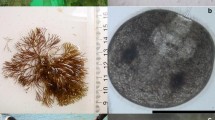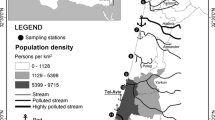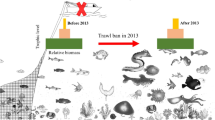Abstract
In the United Kingdom, the use of TBT-based anti-fouling paints on small vessels was banned in 1987, and a biological study of the Crouch Estuary, a yachting centre on the south-eastern coast of the UK, was conducted in order to determine the ecological improvements resulting from this legislation. We present the changes in the macro-infaunal communities along the estuary in relation to declining TBT concentrations between 1987 and 2005. Although the major changes in response to the ban were observed within the first 3 years (primarily an increase in the number of crustacean taxa and a shift in community structure), with changes still apparent between three and 5 years, the temporal duration of this study allowed the rapidity of the response to be truly determined.
Similar content being viewed by others
References
Bolam, S. G., Schratzberger, M., & Whomersley, P. (2004). Macrofaunal recolonization in intertidal mudflats: The effect of organic content and particle size. Journal of Experimental Marine Biology and Ecology, 306, 157–180.
Clark, R. B. (1989). Marine pollution, 2nd ed. (220 pp). Oxford: Clarendon.
Clarke, K. R., & Gorley, R. N. (2006). PRIMER v6: User Manual/Tutorial. Primer-E, PML, Plymouth, UK 190 pp.
Clarke, K. R., & Warwick, R. M. (1994). Change in marine communities: An approach to statistical analysis and interpretation. Plymouth Marine Laboratory, Natural Environment Research Council, UK, 144 pp.
Cledon, M., Theobald, N., Gerwinski, W., & Penchaszedeh, P. E. (2006). Imposex and organotin compounds in marine gastropods and sediments from the Mar Del Plata coast, Argentina. Journal of the Marine Biological Association of the UK, 86, 751–755.
Dahllof, I., Agrenius, S., Blanck, H., Hall, P., Magnusson, K., & Molander, S. (2001). The effect of TBT on the structure of a marine sediment community – A boxcosm study. Marine Pollution Bulletin, 42, 689–695.
Dowson, P. H., Bubb, J. M., & Lester, J. N. (1993). Temporal distribution of organotins in the aquatic environment: Five years after the 1987 UK retail ban on TBT based antifouling paints. Marine Pollution Bulletin, 26, 487–494.
Fioroni, P., Oehlmann, J., & Stroben, E. (1991). The pseudohermaphroditism of prosobranchs; morphological aspects. Zoologischer Anzeiger, 226, 1–26.
Folk, R. L. (1980). Petrology of sedimentary rocks (184 pp.). Texas, USA: Hemphill.
Great Britain-Parliament (1985). Food and Environment Protection Act, 1985. Her Majesty’s Stationary Office, London, 38 pp., Chapter 48.
Hawkins, S. J., Gibbs, P. E., Pope, N. D., Burt, G. R., Chesman, B. S., Bray, S. et al. (2002). Recovery of polluted ecosystems: The case for long-term studies. Marine Environmental Research, 54, 215–222.
Hoch, M. (2001). Organotin compounds in the environment – An overview. Applied Geochemistry, 16, 719–743.
Kelly, J. R., Rudnick, D. T., Morton, D., Buttel, L. A., & Levine, S. N. (1990). Tributyltin and invertebrates of a seagrass ecosystem: Exposure and repsonse of different species. Marine Environmental Research, 29, 245–276.
Langston, W. J., & Burt, G. R. (1991). Bioavailability and effects of sediment-bound TBT in deposit-feeding clams, Scrobicularia plana. Marine Environmental Research, 32, 61–77.
Langston, W. J., Gibbs, P. E., Pascoe, P. L., Chesman, B. S., Burt, G. R., Pope, N. D. et al. (2000). Tributyltin (TBT) impact in the Thames estuary. Plymouth Marine Laboratory and Environmental Agency, Thames Region.
Lapota, D., Rosenberger, D. E., Platter-Reiger, M. F., & Seligmann, P. F. (1992). Growth and survival of Mytilus edulis larvae exposed to low levels of dibutyltin and tributyltin. Marine Biology, 115, 413–419.
Matthiessen, P., & Gibbs, P. E. (1998). Critical appraisal of the evidence for tributyltin- mediated endocrine disruption in molluscs. Environmental Toxicology and Chemistry, 17, 37–43.
Matthiessen, P., Kilbride, R., Mason, C., Pendle, M., Rees, H., & Waldock, R. (1999). Monitoring the recovery of the benthic community in the River Crouch following TBT contamination. Final report for the Department of the Environment, Transport and the Regions (EPG 1/5/92), CEFAS, Burnham-on-Crouch, Essex.
Matthiessen, P., Waldock, R., Thain, J. E., Waite, M. E., & Scrope-Howe, S. (1995). Changes in periwinkle (Littorina littorea) populations following the ban on TBT-based antifoulings on small boats in the United Kingdom. Ecotoxicology and Environmental Safety, 30, 180–194.
Miller, B., & Boyle, J. (2003). Assessment of TBT impacts and concentrations in Loch Ryan, Scotland. Scottish Environment Protection Agency, Tidal Waters, East Kilbride, Glasgow.
Rees, H. L., Waldock, R., Matthiessen, P., & Pendle, M. A. (1999). Surveys of the epibenthos of the Crouch estuary (United Kingdom) in relation to TBT contamination. Journal of the Marine Biological Association UK, 79, 209–223.
Rees, H. L., Waldock, R., Matthiessen, P., & Pendle, M. A. (2001). Improvements in the epifauna of the Crouch Estuary (United Kingdom) following a decline in TBT concentrations. Marine Pollution Bulletin, 42(2), 137–144.
Ruiz, J. M., Bachelet, G., Caumette, P., & Donard, O. F. X. (1996). Three decades of tributyltin in the coastal environment with emphasis on Arcachon Bay, France. Environmental Pollution, 93, 195–203.
Ruiz, J. M., Bryan, G. W., Wigham, G. D., & Gibbs, P. E. (1995). Effects of Tributyltin (TBT) exposure on the reproduction and embryonic development of the bivalve Scrobicularia plana. Marine Environmental Research, 40, 363–379.
Smith, B. S. (1971). Sexuality in the American mud snail, Nassarius obsoletus (Say). Proceedings of the Malacological Society of London, 39, 377–378.
Thomas, K. V., Blake, S. J., & Waldock, M. J. (2000). Antifouling paint booster biocide contamination in UK marine sediments. Marine Pollution Bulletin, 40, 739–745.
Waite, M. E., Waldock, M. J., Thain, J. E., Smith, D. J., & Milton, S. M. (1991). Reductions in TBT concentrations in UK estuaries following legislation in 1986 and 1987. Marine Environmental Research, 32, 89–111.
Waldock, M. J., Thain, J. E., & Waite, M. E. (1987). The distribution and potential toxic effects of TBT in estuaries during 1986. Applied Organometallic Chemistry, 1, 287–301.
Waldock, R., Rees, H. L., Matthiessen, P., & Pendle, M. A. (1999). Surveys of the benthic infauna of the Crouch estuary in relation to TBT contamination. Journal of the Marine Biological Association UK, 79, 225–232.
Waldock, M. J., Waite, M. E., Miller, D., Smith, D. J., & Law, R. J. (1989). The determination of total tin and organotin compounds in environmental samples. Aquatic Environmental Protection Analytical Methods, MAFF Directorate of Fisheries Research, Lowestoft. (4), 25 pp.
Webbe, G. (1987). The toxicology of molluscicides. Oxford: Pergamon.
Author information
Authors and Affiliations
Corresponding author
Rights and permissions
About this article
Cite this article
Smith, R., Bolam, S.G., Rees, H.L. et al. Macrofaunal recovery following TBT ban. Environ Monit Assess 136, 245–256 (2008). https://doi.org/10.1007/s10661-007-9680-8
Received:
Accepted:
Published:
Issue Date:
DOI: https://doi.org/10.1007/s10661-007-9680-8




